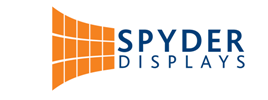What is the difference between the success and failure when running a shopping centre kiosk? The answer lies in knowing how to take advantage of the foot traffic passing by. The ability to stop traffic can be the difference between those who will succeed and live on. The kiosk retailer’s ability to stop passing traffic, or “capture power,” is crucial.
Getting noticed
A great way to increase the capture power of a kiosk is to accentuate how it looks from a distance. Shopping centre customers walk so fast that it takes a bit of effort to slow them down. It’s important that the customer be able to tell what a shopping centre kiosk is selling from at least 12 metres feet away.
Getting noticed from a distance is often a challenge for the retailer. If you sell small items at your kiosk, you need to work on how the product itself can actually work as a sign. For example, a large image of of a product’s packaging can effectively project from a distance what is being sold. Kiosk retailers should put up as large and strongly noticeable signage as possible, within the shopping centres regulations of course. Getting a passing customer to notice and stop does not start at the kiosk itself—it starts 12 metres away, from both directions.
Take a look on both sides of your kiosk at how the traffic flows, as well as the line of sight of the approaching customer. One side of your kiosk may receive more passing traffic than the other. Product and employee placement needs to be based on shopping centre traffic flow and first line of sight. You want to make sure that you have done everything possible to maximise the capture power of your kiosk and make adjustments accordingly. If the back of an employee is the first thing the customer sees when approaching the kiosk, capture power will be less effective. If a customer cannot easily see and understand your product from a distance or does not notice what product is being sold at your kiosk, they won’t slow down or stop. Making adjustments to the products on your kiosk won’t matter if you aren’t being noticed by potential customers in the first place.
Landing the sales
Getting noticed from a distance is only half the battle. The assistance your salesperson gives to a potential customer is key. When the customer is assisted by a salesperson, conversion rates at kiosks go from less than 10 percent to more than 40 percent.
The accessibility of your product also makes a difference. Displaying your product on multiple levels means it is more easily looked at, and therefore more likely to be purchased.
Your kiosk location matters. Do some research into the demographics (gender, age, etc.) of customers that visit each stores around you, adjust your kiosk locations accordingly. Kiosks near Sportsgirl sell different products than kiosks near the National Geographic Shop, for example.
In recent years, shopping centre kiosks have made some headway in being accepted by permanent stores or anchors, and with good reason because kiosks help draw attention to their neighbours window displays. Theoretically, permanent retail neighbors might consider nearby kiosks competitors for the shopper’s attention, but in reality, kiosks act as speed bumps, slowing foot traffic enough to look at nearby anchor window displays as well as the kiosk displays.
The future of kiosks in shopping centres will be steady and incremental, but the thinking behind kiosk design and placement is changing. Performance and accountability is quickly replacing quickly replacing opinion and guesswork.
